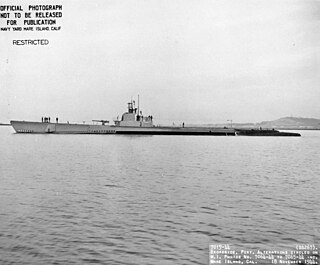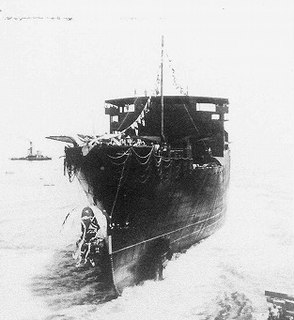
The Mare Island Naval Shipyard (MINSY) was the first United States Navy base established on the Pacific Ocean. It is located 25 miles northeast of San Francisco in Vallejo, California. The Napa River goes through the Mare Island Strait and separates the peninsula shipyard from the main portion of the city of Vallejo. MINSY made a name for itself as the premier US West Coast submarine port as well as serving as the controlling force in San Francisco Bay Area shipbuilding efforts during World War II. The base closed in 1996 and has gone through several redevelopment phases. It was registered as a California Historical Landmark in 1960, and parts of it were declared a National Historic Landmark District in 1975.

USS Marlin (SST-2), originally USS T-2 (SST-2), was a T-1-class training submarine in commission from 1953 to 1973. She was the second submarine of the United States Navy to be named for the marlin, a large game fish. Except for the first 25 early development pre-WWI subs, she was one of the smallest operational submarines ever built for the U.S. Navy.

The Balao class was a successful design of United States Navy submarine used during World War II, and with 120 units completed, the largest class of submarines in the United States Navy. An improvement on the earlier Gato class, the boats had slight internal differences. The most significant improvement was the use of thicker, higher yield strength steel in the pressure hull skins and frames, which increased their test depth to 400 feet (120 m). Tang actually achieved a depth of 612 ft (187 m) during a test dive,
and exceeded that test depth when taking on water in the forward torpedo room while evading a destroyer.

USS Chopper (SS/AGSS/IXSS-342), a Balao-class submarine, was the only ship of the United States Navy to be named for the chopper, a bluefish common in the rivers of the Mississippi Valley. Her keel was laid down by the Electric Boat Company in Groton, Connecticut. She was launched on 4 February 1945 sponsored by Mrs. G. S. Beebe, and commissioned on 25 May 1945 with Lieutenant Commander S. Filipone in command.
A nuclear submarine is a submarine powered by a nuclear reactor. The performance advantages of nuclear submarines over "conventional" submarines are considerable. Nuclear propulsion, being completely independent of air, frees the submarine from the need to surface frequently, as is necessary for conventional submarines. The large amount of power generated by a nuclear reactor allows nuclear submarines to operate at high speed for long periods of time; and the long interval between refuelings grants a range virtually unlimited, making the only limits on voyage times being imposed by such factors as the need to restock food or other consumables.

USS Pompon (SS/SSR-267), a Gato-class submarine, was a ship of the United States Navy named for the pompon, an American fish of the Anisot family.

USS Sunfish (SS-281), a Gato-class submarine, was the first ship of the United States Navy to be named for the ocean sunfish, Mola Mola, a plectognath marine fish, having a deep body truncated behind, and high dorsal and anal fins.
Batfish is a name given to several fishes:

Battleship Memorial Park is a military history park and museum located on the western shore of Mobile Bay in Mobile, Alabama. It has a collection of notable aircraft and museum ships including the South Dakota-class battleship USS Alabama and Gato-class submarine USS Drum. USS Alabama and USS Drum are both National Historic Landmarks; the park as a whole was listed on the Alabama Register of Landmarks and Heritage prior to that time, on October 28, 1977.

Gordon Waite Underwood was a United States Navy captain who was awarded the Navy Cross for his achievements during World War II. He is the namesake of the ship USS Underwood (FFG-36).
Shin'yō (神鷹) "Divine Hawk") was an escort carrier operated by the Imperial Japanese Navy, converted from the German ocean liner Scharnhorst. The liner had been trapped in Kure, Japan following the outbreak of World War II in Europe, which prevented any attempt for the ship to return to Germany. The Japanese Navy then purchased the ship, and after the Battle of Midway in June 1942, decided to convert her into an aircraft carrier. Conversion work lasted from 1942 to late 1943, and Shin'yō was commissioned into the Japanese Navy in December 1943. After entering service, Shin'yō was employed as a convoy escort in the western Pacific. She served in this capacity for less than a year; in November 1944, the US submarine Spadefish torpedoed Shin'yō while she was en route to Singapore. As many as four torpedoes hit the ship and detonated her aviation fuel tanks. The resulting explosion destroyed the ship and killed most of her crew.

The 5"/25 caliber gun entered service as the standard heavy anti-aircraft (AA) gun for United States Washington Naval Treaty cruisers commissioned in the 1920s and 1930s. The goal of the 5"/25 design was to produce a heavy AA gun that was light enough to be rapidly trained manually. The gun was also mounted on pre-World War II battleships and aircraft carriers until replaced by the standard dual-purpose 5"/38 caliber gun, which was derived from the 5"/25 and was similar except for the barrel length. Guns removed from battleships were probably converted for submarine use by late 1943, while a purpose-built variant for submarines was available in mid-1944, and was widely used by them. United States naval gun terminology indicates the gun fired a projectile 5 inches (127 mm) in diameter, and the barrel was 25 calibers long.
William M. Hobby (1899–1942), was a United States Navy officer killed in action during World War II for whom a U.S. Navy ship was named.

Convoy Hi-81 (ヒ-81) was the designation for a formation of Japanese transports that carried soldiers bound for Singapore and the Philippines during World War II. The transports were escorted by a large force of surface combatants including the escort carriers Shinyo and Akitsu Maru which were sunk in the Yellow Sea by American submarines. Over the course of a four-day convoy battle in November 1944 nearly 7,000 Japanese were killed in action while the Americans sustained no casualties.

Tamatsu Maru was a World War II Japanese landing craft depot ship completed in January 1944 and remembered for the heavy loss of life when sunk by USS Spadefish during a 19 August 1944 typhoon. Some 4,890 lives were lost.
Mayasan Maru was a Japanese landing craft depot ship used extensively to transport Imperial Japanese Army (IJA) troops during 1943 and 1944. After avoiding damage in seven separate submarine attacks in earlier convoys, she was sunk in the East China Sea by the submarine USS Picuda on 17 November 1944 while part of Convoy Hi-81. The sinking caused one of the highest maritime casualty counts of World War II. Some 3,536 lives were lost.

Convoy Hi-71 (ヒ-71) was one of the World War II Hi convoys of fast tankers and troop transports from Japan to Singapore. The heavily defended convoy was specially loaded with reinforcements for defense of the Philippines, and encountered a wolfpack of United States Navy submarines in the South China Sea after being scattered by an August 1944 typhoon. Personnel losses were high because heavy seas prevented rescue of crewmen from sunken ships.
Edogawa Maru (Kanji:江戸川丸) was a 6,968 ton Japanese transport ship that was sunk by USS Sunfish on 18 November 1944 with 2,114 lives lost.











